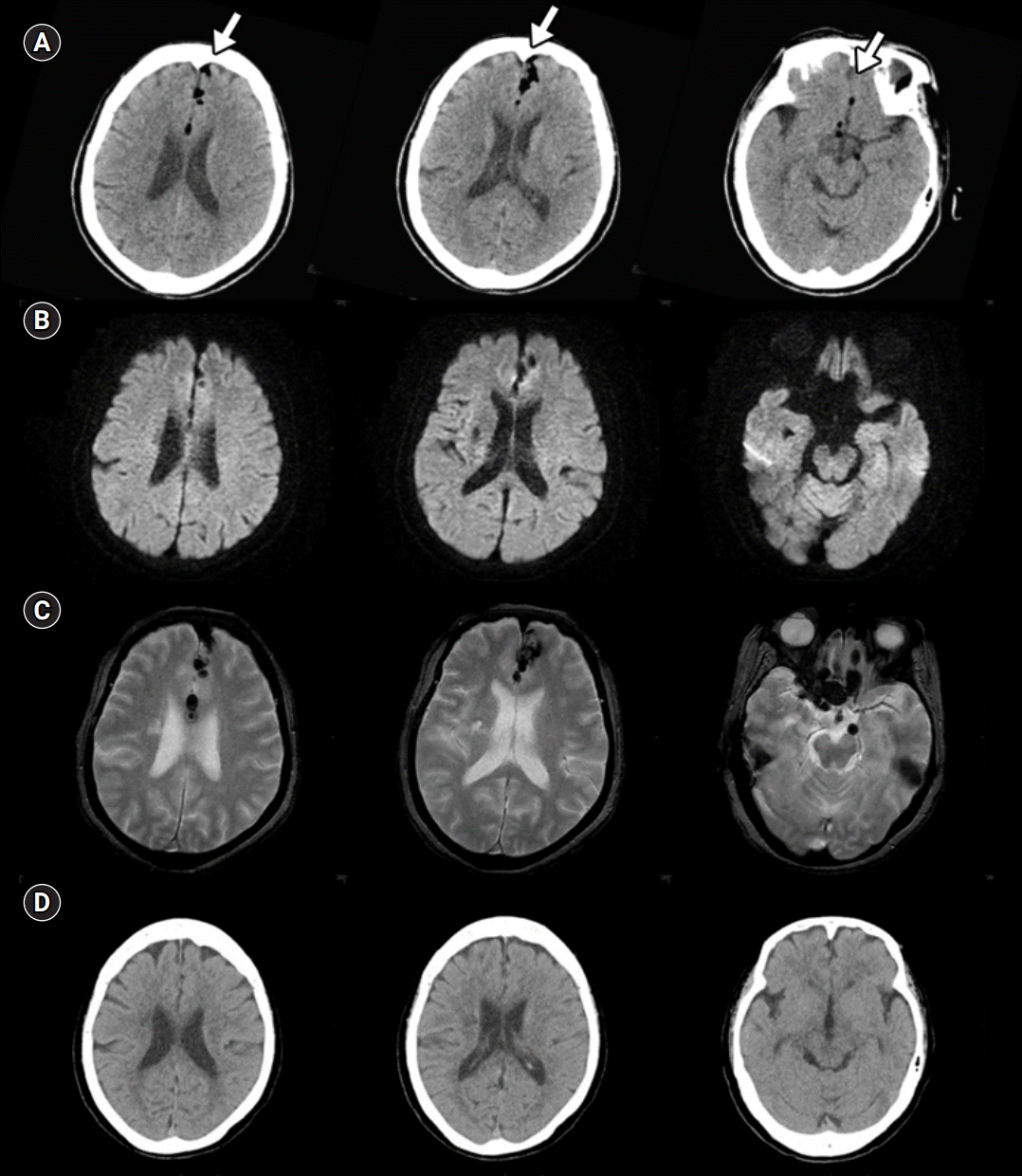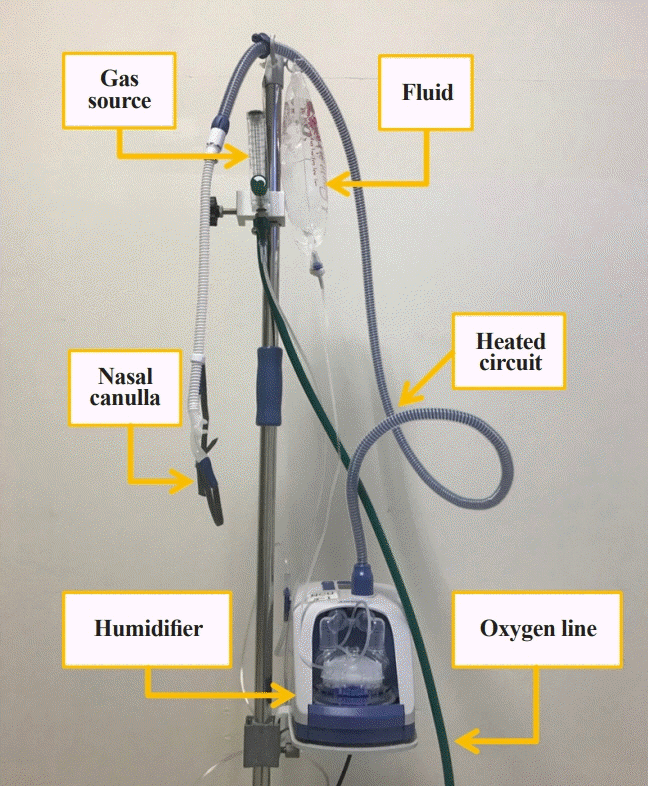This article has been
cited by other articles in ScienceCentral.
Abstract
Background
Oxygen supplementation through a high-flow nasal cannula (HFNC) is a powerful technique that promotes the absorption of air by delivering high concentrations of oxygen to patients who are not intubated, and may be a viable treatment option for pneumocephalus.
Case Report
A 75-year-old female presented in a stuporous state. She had received an epidural injection due to back pain 2 hours ago. Non-contrast brain computed tomography revealed a pneumocephalus at the interhemispheric fissure and the prepontine cistern. HFNC oxygen therapy at 60 L/min with a fraction of inspired oxygen of 1 was started. By the next morning, her mental status had recovered and a repeat brain computed tomography 15 hours later revealed complete absorption of the pneumocephalus.
Conclusion
Supplemental high oxygen via HFNC can be successfully used in patients with pneumocephalus who are not intubated and mechanically ventilated.
Go to :

Keywords: Pneumocephalus, High-flow nasal cannula, Oxygen therapy
INTRODUCTION
Pneumocephalus is defined as the presence of air or gas in the intracranial cavity [
1]. Although, pneumocephalus commonly occurs after trauma, it can also be associated with other conditions including neurosurgical procedures, infection, neoplasm, barotrauma, and spinal and epidural anesthesia [
1]. Treatment of pneumocephalus is controversial; however, supplementation with high concentrations of oxygen can promote the absorption of pneumocephalus [
2-
4]. High-flow nasal cannula (HFNC) oxygen supplementation technique is commonly used in intensive care units to supply high concentrations of oxygen to patients without intubation [
5-
7]. Oxygen therapy via HFNC can be a viable treatment option for pneumocephalus [
8].
We report a case of pneumocephalus that occurred following an epidural injection and was successfully treated with supplemental oxygen delivery via HFNC.
Go to :

CASE REPORT
A 75-year-old female presented in a stuporous state. Her medical history included basal ganglia infarction and hypertension. Two hours ago, she received an epidural injection due to back pain. A mixture of lidocaine and triamcinolone was injected into the epidural space of the thoracic spinal cord. Twenty minutes after the injection, she experienced nausea, followed by decreased consciousness to the level of stupor. Epinephrine was administrated for suspicion of anaphylaxis. Although her mental status improved to drowsy, she remained confused and was transferred to the emergency room of our hospital.
Vital signs on admission were normal. She was somnolent and confused but other neurological examinations were unremarkable. Routine laboratory tests, including arterial blood gas analysis (pH, 7.449; PCO
2, 45.2 mm Hg; PO
2, 73.2 mm Hg; and SaO
2, 94.1%), were normal. Non-contrast brain computed tomography revealed a pneumocephalus at the interhemispheric fissure and the prepontine cistern (
Fig. 1). Brain magnetic resonance imaging confirmed the pneumocephalus (
Fig. 1). Although the patient was in a stuporous state, vital signs, including respiration, were stable. We decided to employ a noninvasive oxygen device, and oxygen therapy via HFNC at 60 L/min with a fraction of inspired oxygen (FiO
2) of 1 was started (
Fig. 2). After 6 hours, arterial oxygen partial pressure increased from 73.2 to 472 mm Hg. Seventeen hours after symptom onset, her mental status returned to alert and repeat brain computed tomography 15 hours later revealed the complete absorption of the pneumocephalus (
Fig. 1).
 | Fig. 1.(A) Non-contrast brain computed tomography revealing pneumocephalus at the interhemispheric fissure and the prepontine cistern (white arrows). (B) Diffusion-weighted image and (C) gradient-echo also reveal pneumocephalus. (D) Follow-up brain computed tomography 15 hours later demonstrates the complete absorption of the pneumocephalus. 
|
 | Fig. 2.High-flow nasal cannula oxygen therapy at 60 L/min, with fraction of inspired oxygen (FiO2) of 1, was started. 
|
Go to :

DISCUSSION
This case demonstrated that a symptomatic pneumocephalus can be successfully treated using oxygen supplementation via HFNC. After application of HFNC, the patient’s symptoms improved and brain computed tomography performed 1 day later revealed absorption of the pneumocephalus. High-concentration oxygen therapy has been suggested to be effective for symptomatic pneumocephalus [
2-
4]. To provide a consistent FiO
2, patients require mechanical ventilation after endotracheal intubation [
9]. Although conventional oxygen devices, such as nasal cannulas or oxygen masks, can also be used, high concentrations of oxygen are not consistently delivered [
6,
7]. HFNC may be an effective treatment option for pneumocephalus to administer high concentrations of oxygen without the need for endotracheal intubation.
In this patient, pneumocephalus developed after an epidural injection. Previous case reports have described pneumocephalus after epidural injection, and it was presumed that the dura mater was damaged during the procedure [
10]. The loss-of-resistance to air technique is commonly used to confirm entry into the epidural space, which is considered the source of air entry. When the spinal needle reaches the epidural space, resistance quickly disappears, and air in the syringe may be inadvertently injected.
Mild cases of pneumocephalus without clinical manifestations usually resolve without treatment and are absorbed spontaneously. More severe pneumocephalus, however, can cause headache, nausea, vomiting, seizure, lethargy, and neurological deficits [
11]. Supplemental oxygen is a commonly accepted treatment for pneumocephalus with clinical symptoms [
1-
4]. Oxygen augmentation reduces pulmonary nitrogen levels, creating a nitrogen gradient, and nitrogen in the pneumocephalus diffuses into the lungs via the blood [
2]. Some prospective studies have shown that oxygen therapy can reduce pneumocephalus after neurosurgery [
3,
4]. One case series reported that HFNC improved pneumocephalus symptoms in postneurosurgical patients within a few hours [
8].
HFNC is an effective and powerful technique increasingly used in intensive care units. Several studies have demonstrated that HFNC improves the management of hypoxic respiratory failure and reduces the number of patients who require reintubations [
5]. HFNC provides high flow rates (up to 60 L/min) through nasal cannulas by delivering heated and humidified oxygen. Patients undergoing oxygen therapy with HFNC exhibit better tolerance and experience greater comfort than with conventional oxygen-delivery devices [
6,
7]. Due to these advantages, HFNC can be used for various indications, including pneumocephalus, in the neurological intensive care unit.
This case demonstrated the therapeutic effect of HFNC in a patient with pneumocephalus. Owing to the limited extent of pneumocephalus on the first brain computed tomography, it is difficult to rule out spontaneous improvement. However, the application of HFNC may have contributed to the rapid recovery.
In conclusion, supplemental oxygen via HFNC can be successfully used in patients with pneumocephalus who are not intubated and mechanically ventilated.
Go to :






 PDF
PDF Citation
Citation Print
Print




 XML Download
XML Download